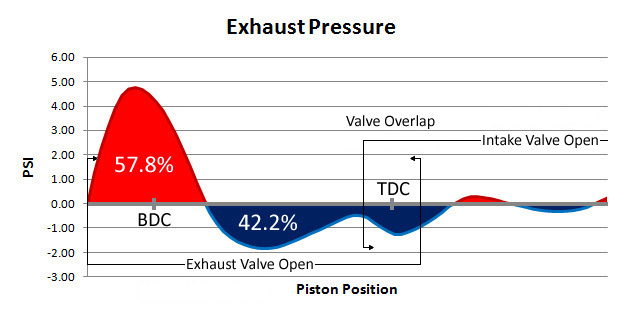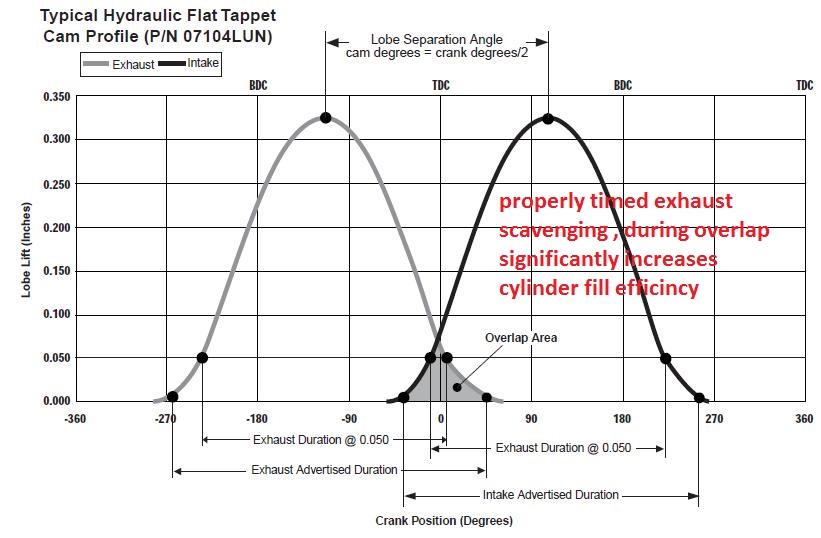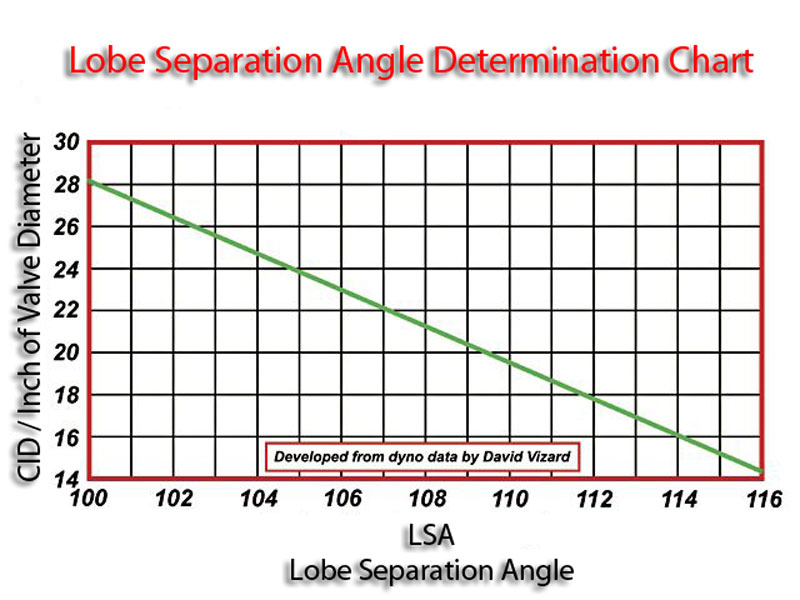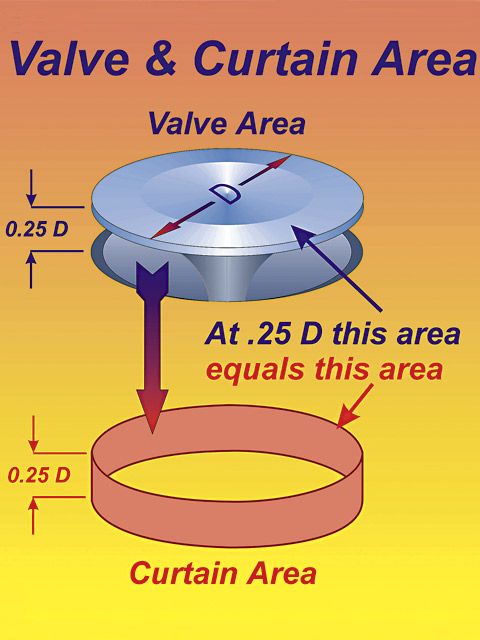its a design feature that's mostly due to the fact that many cam manufacturers designs are built to compensate for a restricted exhaust system, that requires more time for the pressure in the cylinder to bleed off. It benefits the engine power curve if your headers or exhaust behind the headers is a bit restrictive in that it adds additional time that the exhaust valves off its seat thus allowing a marginal increase in the time the exhaust flow has to exit the cylinder and for EXHAUST SCAVENGING during the overlap period when BOTH VALVES ARE OFF thier seats thus it tends to increase the cylinder fill efficiency IF the exhaust is a bit restrictive.
Id point out that in many cases using a 1.6:1 ratio intake rocker vs the stock 1.5:1 ratio helps power, but adding a 1.6:1 rarely seems to have the same results when using those split duration cam designs keep in mind only air pressure forces flow into a cylinder but the exhaust is mechanically forced out by the piston and with a correctly designed header theres a negative pressure at the exhaust port that further helps suck or scavenge the cylinder and draw in the intake port charge

Id also point out that cam timing matched to the exhaust scavenging has a huge effect on potential intake flow rates





HERES WHAT ISKI CAMS SAYS
"Longer Exhaust Duration: Is this really necessary?Most stock camshafts from American production V8, V6 and 4 cylinder engines manufactured today are ground with the longer exhaust lobe duration. Or, another way of looking at this is that they are ground with shorter intake durations! The former embraces the viewpoint that either the Exhaust Ports or Exhaust Pipe system is somewhat restrictive, and is in need of an assist. The latter suggests that the intake system is rather efficient and cam timing can be trimmed back a bit with out much sacrifice in power, in order to maximize throttle response and cruising efficiency.
Take your pick here. There is no absolutely correct viewpoint - because both are probably true! In a stock engine running at conservative RPM levels, for the sake of overall efficiency, fuel economy and a quiet smooth running engine, this staggering of intake and exhaust duration is quite common and appropriate.
However, High Performance is another thing entirely. Change one factor, let's say in this case, the exhaust system (installing headers and larger pipes) and you have just negated in most cases, the need for that longer exhaust lobe. Now couple this change with a different intake system and camshaft and you have really scrambled the equation. But, wait just a moment. Why is it that so many people (racers & cam grinders alike) insist on running a cam with longer exhaust duration regardless of what equipment is employed? The answer is "habit". Most of them have been somewhat successful in doing it their way and will probably never change unless virtually forced by circumstances to do so.
Before we go any further however let's review what it actually is we are trying to do with an engine when we attempt to make more power. Our best result comes when we are cognizant of the fact that an engine is basically an air pump. We pump it in and out (although in a different form) and we have problems when one side or the other is restricted. Balance or the equilibrium or flow should be our objective, unless of course we are not trying to make more horsepower!
Example #1 (Oval track racing) Here, I have often observed that the most experienced drivers are those who are most likely to run a single pattern (equal on intake and exhaust duration) cam. Why? Because such cams always, I repeat always make more torque! These veterans have a more educated foot and greater experience in feathering the throttle in the corners. They can therefore, utilize the benefit of added torque, in the lower to mid RPM range, to their advantage.
Their counterparts, the younger drivers on the circuit, generally are not as experienced and may at times actually get "crossed up" in the corners especially with a lighter car or when they are learning the ropes. In their case, a longer exhaust duration is often the more appropriate choice. It will often help them to drive better, more "flat footed" if you will, without consequence. But please for the sake of accuracy, let us be truthful. The benefit comes from an actual bleeding off of low to mid range torque, which is always what happens when Exh. Duration is lengthened, not from any improvement. The improvement, (if any) would come because of an improvement in scavenging at the extreme upper end of the power curve and would usually be marginal at best. Yet the so-called "extra power" potential of a longer Exh. Duration cam is most often why they are touted - power most people are backing away from at the end of the strait away!
Example #2 (Drag Racing) At the drag strip it's a little different and I feel more honest. Here, racers have long enjoyed longer exhaust and longer durations across the board (If I may add specifically for the purpose of "killing" low-end torque) to keep the tires from too easily breaking lose. This has been successful and sometimes actually results in a slight increase in top end power - something you can actually use in drag racing since it is a full throttle endeavor through the lights. Keep in mind here though, it's quite possible that a longer duration cam overall would have done just as well or better. In other words if you needed that longer exhaust for top end, perhaps the intake could have benefited from such a lengthening as well.
One of my favorite expressions is how "The Drag Racing mentality has infiltrated the ranks of Oval Track". Many have crossed over and made the switch in the past 10-15 years and some have brought their preconceived notions about how to cam an engine with them. A few may actually read these concepts and if they do so will at least come away with a better understanding of what they are doing. On the other hand they also could find that this information might actually help their cars to run just a bit faster!"
of course you'll want to match the heads you select,
to the intended rpm/power range and application and match the cam timing, compression ratio, and drive train gearing, etc.
so lets discus the current car/truck weight, transmission, tire size, rear gear ratio and what your intended goals and budget limitations are, as a start point.
the last thing you'll want to do is select parts that may cripple or restrict the engine performance by mis-matching components or selecting parts on price alone, we all work on limited budgets,
but its will pay big dividends in power produced too carefully select matched components
and generally the biggest mistake is mis-matching heads, intake and cam combos or scrimping on the quality of the components used,
a couple extra hours or even days spent in detailed of research may prove critical, in fact anything less than buying and reading through several books and reading a couple dozen links and all the sub-links is very likely to leave you missing valuable and critical info youll need later, and thats usually going to cost you wasted time and cash.
the big mistake's most people make is in not selecting the correct cam, to match the displacement and compression and drive train gearing or selecting a restrictive cylinder head or intake that does not match the intended power range
yes it looks over whelming but youll be amazed at the detailed info and the mistakes you can avoid by reading carefully
http://garage.grumpysperformance.com/index.php?threads/sellecting-cylinder-heads.796/
http://garage.grumpysperformance.com/index.php?threads/semi-fool-proof-cam-sellection.82/
http://garage.grumpysperformance.com/index.php?threads/first-hotrod-build.12902/#post-67005
http://garage.grumpysperformance.co...ing-a-383-sbc-combo-planing.12168/#post-58778
http://garage.grumpysperformance.com/index.php?threads/bare-minimum-tools.11026/#post-48785
http://garage.grumpysperformance.com/index.php?threads/matching-parts-and-a-logical-plan.7722/
http://garage.grumpysperformance.com/index.php?threads/what-to-look-for-in-a-good-engine-combo.9930/
http://garage.grumpysperformance.com/index.php?threads/another-383-build.12786/
http://garage.grumpysperformance.com/index.php?threads/383-information-overload.11137/
http://garage.grumpysperformance.com/index.php?threads/a-383-build.10991/
http://garage.grumpysperformance.com/index.php?threads/impersonator.9600/
http://garage.grumpysperformance.co...e-springs-and-setting-up-the-valve-train.181/
http://garage.grumpysperformance.com/index.php?threads/port-speeds-and-area.333/
http://garage.grumpysperformance.com/index.php?threads/valve-seat-angles-and-air-flow.8460/
http://garage.grumpysperformance.com/index.php?threads/tbucket-engine-project-dart-shp.3814/
Id point out that in many cases using a 1.6:1 ratio intake rocker vs the stock 1.5:1 ratio helps power, but adding a 1.6:1 rarely seems to have the same results when using those split duration cam designs keep in mind only air pressure forces flow into a cylinder but the exhaust is mechanically forced out by the piston and with a correctly designed header theres a negative pressure at the exhaust port that further helps suck or scavenge the cylinder and draw in the intake port charge

Id also point out that cam timing matched to the exhaust scavenging has a huge effect on potential intake flow rates





HERES WHAT ISKI CAMS SAYS
"Longer Exhaust Duration: Is this really necessary?Most stock camshafts from American production V8, V6 and 4 cylinder engines manufactured today are ground with the longer exhaust lobe duration. Or, another way of looking at this is that they are ground with shorter intake durations! The former embraces the viewpoint that either the Exhaust Ports or Exhaust Pipe system is somewhat restrictive, and is in need of an assist. The latter suggests that the intake system is rather efficient and cam timing can be trimmed back a bit with out much sacrifice in power, in order to maximize throttle response and cruising efficiency.
Take your pick here. There is no absolutely correct viewpoint - because both are probably true! In a stock engine running at conservative RPM levels, for the sake of overall efficiency, fuel economy and a quiet smooth running engine, this staggering of intake and exhaust duration is quite common and appropriate.
However, High Performance is another thing entirely. Change one factor, let's say in this case, the exhaust system (installing headers and larger pipes) and you have just negated in most cases, the need for that longer exhaust lobe. Now couple this change with a different intake system and camshaft and you have really scrambled the equation. But, wait just a moment. Why is it that so many people (racers & cam grinders alike) insist on running a cam with longer exhaust duration regardless of what equipment is employed? The answer is "habit". Most of them have been somewhat successful in doing it their way and will probably never change unless virtually forced by circumstances to do so.
Before we go any further however let's review what it actually is we are trying to do with an engine when we attempt to make more power. Our best result comes when we are cognizant of the fact that an engine is basically an air pump. We pump it in and out (although in a different form) and we have problems when one side or the other is restricted. Balance or the equilibrium or flow should be our objective, unless of course we are not trying to make more horsepower!
Example #1 (Oval track racing) Here, I have often observed that the most experienced drivers are those who are most likely to run a single pattern (equal on intake and exhaust duration) cam. Why? Because such cams always, I repeat always make more torque! These veterans have a more educated foot and greater experience in feathering the throttle in the corners. They can therefore, utilize the benefit of added torque, in the lower to mid RPM range, to their advantage.
Their counterparts, the younger drivers on the circuit, generally are not as experienced and may at times actually get "crossed up" in the corners especially with a lighter car or when they are learning the ropes. In their case, a longer exhaust duration is often the more appropriate choice. It will often help them to drive better, more "flat footed" if you will, without consequence. But please for the sake of accuracy, let us be truthful. The benefit comes from an actual bleeding off of low to mid range torque, which is always what happens when Exh. Duration is lengthened, not from any improvement. The improvement, (if any) would come because of an improvement in scavenging at the extreme upper end of the power curve and would usually be marginal at best. Yet the so-called "extra power" potential of a longer Exh. Duration cam is most often why they are touted - power most people are backing away from at the end of the strait away!
Example #2 (Drag Racing) At the drag strip it's a little different and I feel more honest. Here, racers have long enjoyed longer exhaust and longer durations across the board (If I may add specifically for the purpose of "killing" low-end torque) to keep the tires from too easily breaking lose. This has been successful and sometimes actually results in a slight increase in top end power - something you can actually use in drag racing since it is a full throttle endeavor through the lights. Keep in mind here though, it's quite possible that a longer duration cam overall would have done just as well or better. In other words if you needed that longer exhaust for top end, perhaps the intake could have benefited from such a lengthening as well.
One of my favorite expressions is how "The Drag Racing mentality has infiltrated the ranks of Oval Track". Many have crossed over and made the switch in the past 10-15 years and some have brought their preconceived notions about how to cam an engine with them. A few may actually read these concepts and if they do so will at least come away with a better understanding of what they are doing. On the other hand they also could find that this information might actually help their cars to run just a bit faster!"
of course you'll want to match the heads you select,
to the intended rpm/power range and application and match the cam timing, compression ratio, and drive train gearing, etc.
so lets discus the current car/truck weight, transmission, tire size, rear gear ratio and what your intended goals and budget limitations are, as a start point.
the last thing you'll want to do is select parts that may cripple or restrict the engine performance by mis-matching components or selecting parts on price alone, we all work on limited budgets,
but its will pay big dividends in power produced too carefully select matched components
and generally the biggest mistake is mis-matching heads, intake and cam combos or scrimping on the quality of the components used,
a couple extra hours or even days spent in detailed of research may prove critical, in fact anything less than buying and reading through several books and reading a couple dozen links and all the sub-links is very likely to leave you missing valuable and critical info youll need later, and thats usually going to cost you wasted time and cash.
the big mistake's most people make is in not selecting the correct cam, to match the displacement and compression and drive train gearing or selecting a restrictive cylinder head or intake that does not match the intended power range
yes it looks over whelming but youll be amazed at the detailed info and the mistakes you can avoid by reading carefully
http://garage.grumpysperformance.com/index.php?threads/sellecting-cylinder-heads.796/
http://garage.grumpysperformance.com/index.php?threads/semi-fool-proof-cam-sellection.82/
http://garage.grumpysperformance.com/index.php?threads/first-hotrod-build.12902/#post-67005
http://garage.grumpysperformance.co...ing-a-383-sbc-combo-planing.12168/#post-58778
http://garage.grumpysperformance.com/index.php?threads/bare-minimum-tools.11026/#post-48785
http://garage.grumpysperformance.com/index.php?threads/matching-parts-and-a-logical-plan.7722/
http://garage.grumpysperformance.com/index.php?threads/what-to-look-for-in-a-good-engine-combo.9930/
http://garage.grumpysperformance.com/index.php?threads/another-383-build.12786/
http://garage.grumpysperformance.com/index.php?threads/383-information-overload.11137/
http://garage.grumpysperformance.com/index.php?threads/a-383-build.10991/
http://garage.grumpysperformance.com/index.php?threads/impersonator.9600/
http://garage.grumpysperformance.co...e-springs-and-setting-up-the-valve-train.181/
http://garage.grumpysperformance.com/index.php?threads/port-speeds-and-area.333/
http://garage.grumpysperformance.com/index.php?threads/valve-seat-angles-and-air-flow.8460/
http://garage.grumpysperformance.com/index.php?threads/tbucket-engine-project-dart-shp.3814/
Last edited by a moderator:
